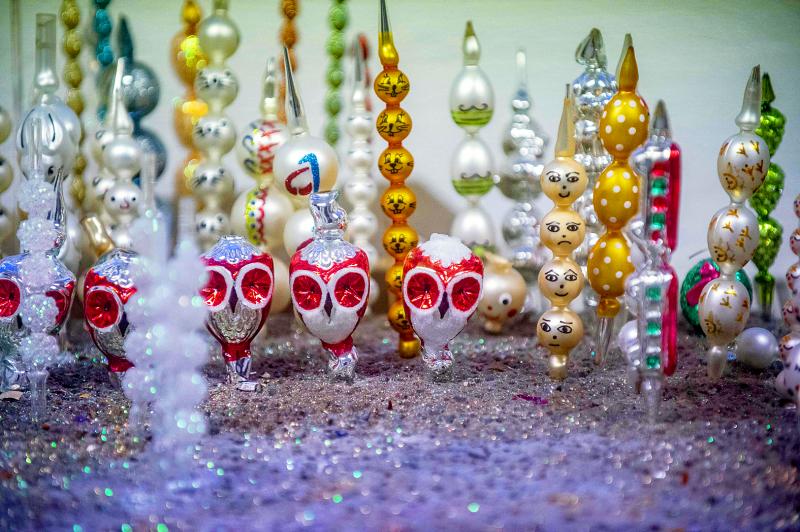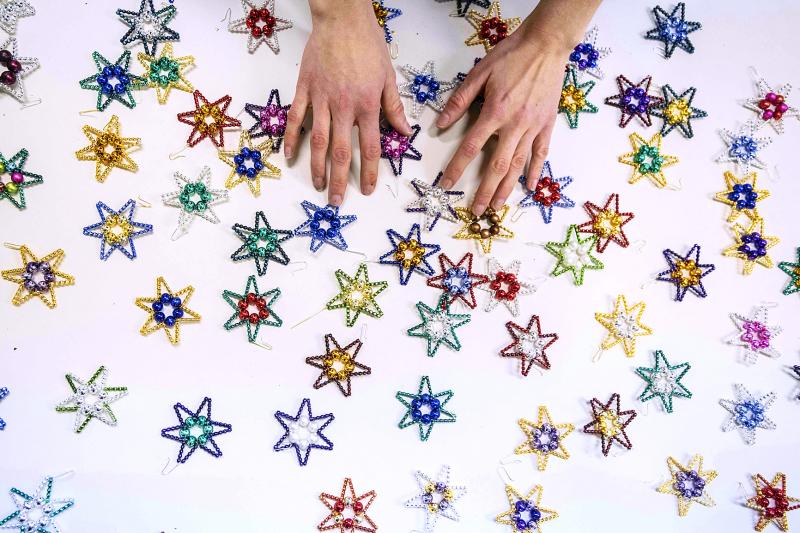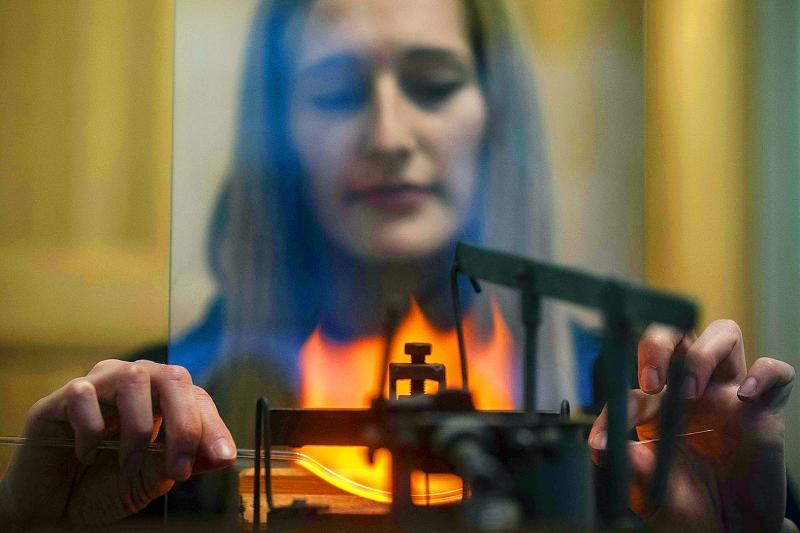Sparkling with colorful glitter, the small glassware shop in the Czech mountains lights up a grim, foggy day, as Christmas shoppers stream in to the constant chime of the doorbell.
They come to buy blown-glass beaded decorations including stars, angels, snowmen, Santa Clauses or cribs made by a small company in Ponikla, a village in the northern Czech Republic.
The “handmade production of Christmas tree decorations from blown glass beads” earned a place on the UNESCO list of intangible cultural heritage last year.

Photo: AFP
The practice has survived until today only in Ponikla, whose local tradition has roots in a 19th-century love affair.
“A certain Mr Hajna fell in love with a local maid, they got married and he brought the very basics of the craft to Ponikla,” says Marek Kulhavy, owner of the local Rautis factory, the only one left. Hajna came from a nearby region where glass making had already flourished, and the craft spread fast as his neighbors were quick to learn it to make their living in the poor mountainous region.
Stanislav Horna opened the current Rautis factory in 1902 to produce fancy trimmings for clothes and costumes and met with great success, employing as many as 200 glass blowers at one point. The company managed to stay afloat even after an act of espionage forced it to redirect its focus to Christmas ornaments.

Photo: AFP
“In the 1920s, a group of Japanese industrial spies disguised as tourists copied the process and started to produce the trimmings, taking the eastern markets away,” Kulhavy said.
“The warehouses were full of beads and somebody decided to start making Christmas decorations as Christmas trees were a hit at the time.”
‘BLESSING IN DISGUISE’

Photo: AFP
In 1948, all of the glass factories were nationalized as the Communists took power in the former Czechoslovakia, and Horna’s son was even thrown into prison like many entrepreneurs.
But the business benefited from the move as the Communists limited blown-glass bead manufacturing to Ponikla.
“It was a blessing in disguise,” says Kulhavy. “Glass beads were always on the fringe [of glass production] and they lived their own life even during Communism as nobody was really interested in them and so the business survived.”
Shortly after the Communist regime was toppled in 1989, Kulhavy’s father bought the Ponikla factory which currently employs 50 people.
Production begins with a glass pipe which is heated and shaped by blowing inside a mold. The plant has more than 1,000 patterns, according to Kulhavy.
The shaped pipe is silvered from inside with a solution and then dyed from outside, before being cut up, threaded with strings and turned into an ornament.
“Some beads are also treated by a painter. For instance angel heads need painted details,” said Kulhavy.
JURASSIC PARK
The Czech market is crucial, but the Ponikla decorations also head to neighboring Austria and Germany and other European countries, as well as Japan and the US.
Facebook fan Iren Hellerova was excited to receive the parcel she ordered, calling the Christmas beads “beautiful.” She said the ornaments make for unique gifts as “no one else in the world has this!” Some beads still end up on regional costumes in the Czech Republic, Germany, the Baltics, the Balkan countries or Latin America. Standing in front of a rack with glass motorbikes, cars and spiders in cobwebs, Kulhavy said the company had about 300 products to offer.
“We once made Jurassic Park and Wild West collections to attract US buyers in the 1990s, they were pretty ugly,” he chuckled.
UNESCO listed the production as a “specialized and technically demanding” craft, hailing the factory for safeguarding the tradition as the sole survivor.
“Glass beads were always a Cinderella. They entered the spotlight thanks to the listing,” Kulhavy said.
“When you cast light on a star, it simply shines.”

On April 26, The Lancet published a letter from two doctors at Taichung-based China Medical University Hospital (CMUH) warning that “Taiwan’s Health Care System is on the Brink of Collapse.” The authors said that “Years of policy inaction and mismanagement of resources have led to the National Health Insurance system operating under unsustainable conditions.” The pushback was immediate. Errors in the paper were quickly identified and publicized, to discredit the authors (the hospital apologized). CNA reported that CMUH said the letter described Taiwan in 2021 as having 62 nurses per 10,000 people, when the correct number was 78 nurses per 10,000

As we live longer, our risk of cognitive impairment is increasing. How can we delay the onset of symptoms? Do we have to give up every indulgence or can small changes make a difference? We asked neurologists for tips on how to keep our brains healthy for life. TAKE CARE OF YOUR HEALTH “All of the sensible things that apply to bodily health apply to brain health,” says Suzanne O’Sullivan, a consultant in neurology at the National Hospital for Neurology and Neurosurgery in London, and the author of The Age of Diagnosis. “When you’re 20, you can get away with absolute

May 5 to May 11 What started out as friction between Taiwanese students at Taichung First High School and a Japanese head cook escalated dramatically over the first two weeks of May 1927. It began on April 30 when the cook’s wife knew that lotus starch used in that night’s dinner had rat feces in it, but failed to inform staff until the meal was already prepared. The students believed that her silence was intentional, and filed a complaint. The school’s Japanese administrators sided with the cook’s family, dismissing the students as troublemakers and clamping down on their freedoms — with

As Donald Trump’s executive order in March led to the shuttering of Voice of America (VOA) — the global broadcaster whose roots date back to the fight against Nazi propaganda — he quickly attracted support from figures not used to aligning themselves with any US administration. Trump had ordered the US Agency for Global Media, the federal agency that funds VOA and other groups promoting independent journalism overseas, to be “eliminated to the maximum extent consistent with applicable law.” The decision suddenly halted programming in 49 languages to more than 425 million people. In Moscow, Margarita Simonyan, the hardline editor-in-chief of the